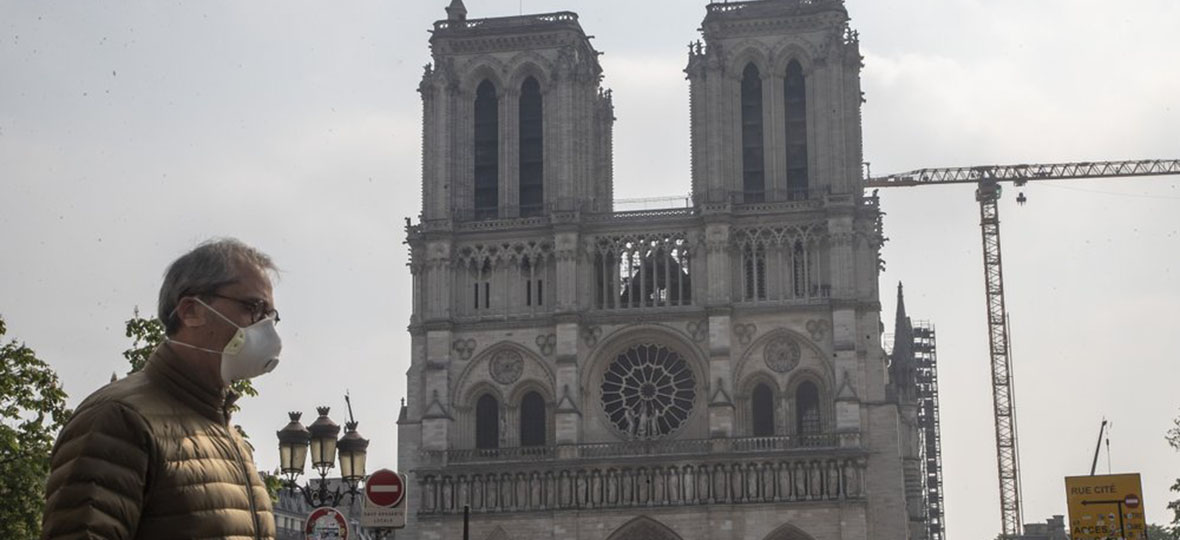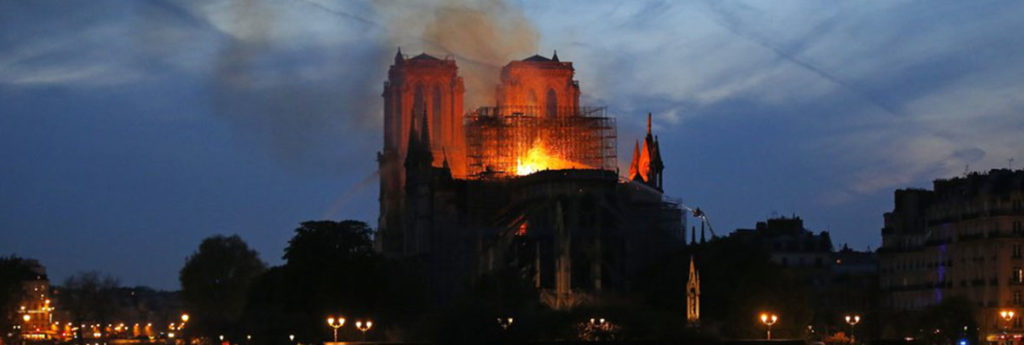It’s been a year since Notre Dame Cathedral in Paris was gutted by fire – a sad anniversary that has been largely overlooked while the world casts its gaze elsewhere. Today, with the city shuttered since March 17 because of the coronavirus pandemic, restoration of the landmark from the 12th and 13th centuries – a Gothic jewel that for many embodies the soul of France – have also been locked down.
Moreover, plans to remove 254 metric tons of unstable scaffolding – erected for an earlier renovation – but warped in the horrific blaze on April 15, 2019, now endanger the remaining structure.
But despite standing crippled and isolated on the Île de la Cité, in the middle of the River Seine, the cathedral’s 13-ton bell in the south tower, named Emmanuel, sounded at 8 p.m. Wednesday night when a man wearing a mask and white protective clothing pulled a rope attached to its enormous clapper. The sounding of the bell joined the nightly applause from balconies in recognition of overstretched health workers.
On Good Friday, Paris Archbishop Michel Aupetit led an exceptional but tiny gathering inside the fragile church, at the foot of the huge golden cross that remains intact, with the hopes of raising the spirits of a nation in distress.
“Today, we stand in this half-fallen cathedral to say that life is still here,” Aupetit said in the televised ceremony, adding later, “The message of hope is especially important for our compatriots at a time when we are particularly affected by the coronavirus, which is sowing anguish and death.”
There was no Easter service and no formal plans to mark the anniversary of the fire. But the musicians of Notre Dame have created a virtual homage to their beloved cathedral with a performance from their homes of an extract of J.S. Bach’s “St. John Passion.”
“As long as we have this scaffolding around, there’s still sort of a 50 percent chance that more damage can be (caused) to the cathedral,” said Notre Dame chaplain Brice de Malherbe, who last year was evacuated from his home next door as flames engulfed the roof.
He recalled his worst moment that night: “When one had the impression that the fire was (subsiding) and suddenly it resumed in one of the towers.”
Yet, Notre Dame remained standing, still surveying the French capital from the island in the Seine, its two familiar bell towers partially eaten from within by flames, but their heavy stones apparently only blackened on the outside.
On Wednesday, French President Emmanuel Macron reiterated his desire to see the cathedral reopen its giant doors in time for the 2024 Olympic Games in Paris.
“We will do everything to keep this deadline,” he said in a tweeted video, adding that Notre Dame “is a symbol of our resilience, our capacity to overcome challenges and stand aright.”
But progress has been delayed by setbacks, from the discovery of toxic dust from the melted lead roof and spire to the health and safety demands of the pandemic.
Officials now hope the scaffolding can be removed by the fall. Then, stones must be analyzed to see which need to be replaced. Debris and huge ancient beams that burned like kindling must be cleared from the soaring vaults, Malherbe said. An umbrella structure will then be built to protect the site, which is surrounded by high barricades.
For one fervent devotee of Notre Dame, the barricades, which replaced a smaller barrier, symbolize her loss, and the virus spreading across France and the world.
“Notre Dame is confined. I couldn’t throw a bouquet of flowers over to her,” said Cecile Deleville, who had tossed one over the lower fencing in December. “It’s as though they took that away, too.”
The 67-year-old retiree fears she won’t see Notre Dame reborn in her lifetime and worries that the reconstruction will fall by the wayside as France tries to rebuild its economy once the virus crisis has been overcome.
Those in charge of returning Notre Dame to its original splendour are still at work, despite being locked down.
The cathedral “has been gravely injured, undeniably so,” Jean-Louis Georgelin, a retired army general appointed by Macron to head the restoration project, said in an interview with the Catholic publication Le Pelerin.
But it has resisted thermal shock from the fire, water from hoses that drenched it for days, the summer heat and high winds, he said, adding that sensors installed to read any movement of the structure have picked up nothing notable.
Donations large and small are helping to pay for the restoration, with 188 million euros received, Georgelin told the daily Le Parisien. Some €400 ($612) million have been promised by the Total oil company and French tycoons Francois Pinault and Bernard Arnault of the luxury giant LVMH. But it was the modest donations, mainly from people in France and the United States, that covered the initial costs.
On Wednesday, Germany offered to help rebuild some of the large clerestory windows located far above eye level. The German government said three glassmakers that conduct restoration work for cathedrals in Germany could offer “great expertise” to their French colleagues.
A timeline for the reconstruction may need to be redrawn to account for the virus lockdown. What also is unclear is what the new spire will look like. Will it be a copy of architect Eugene-Emmanuel Viollet-le-Duc’s 19th century creation in lead that soared 96 meters high, or be a contemporary version?
With Notre Dame still severely damaged, Deleville, the believer who lost her church, cannot muster a vision of the future.
“It makes my heart cry,” she said. “I return, but she isn’t there.”


